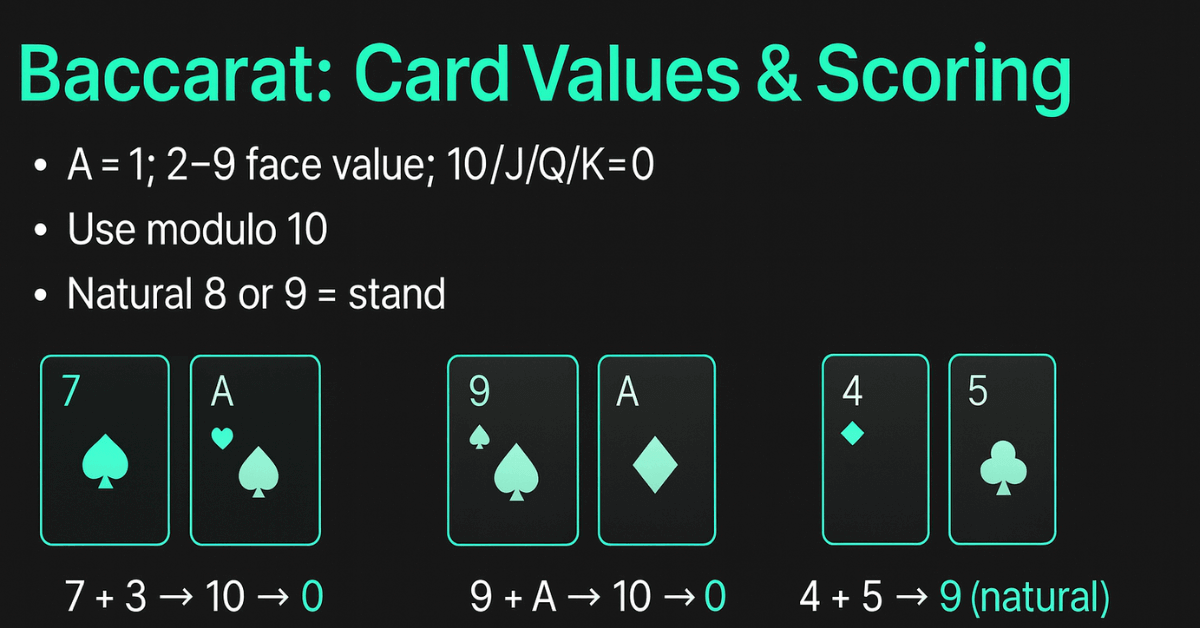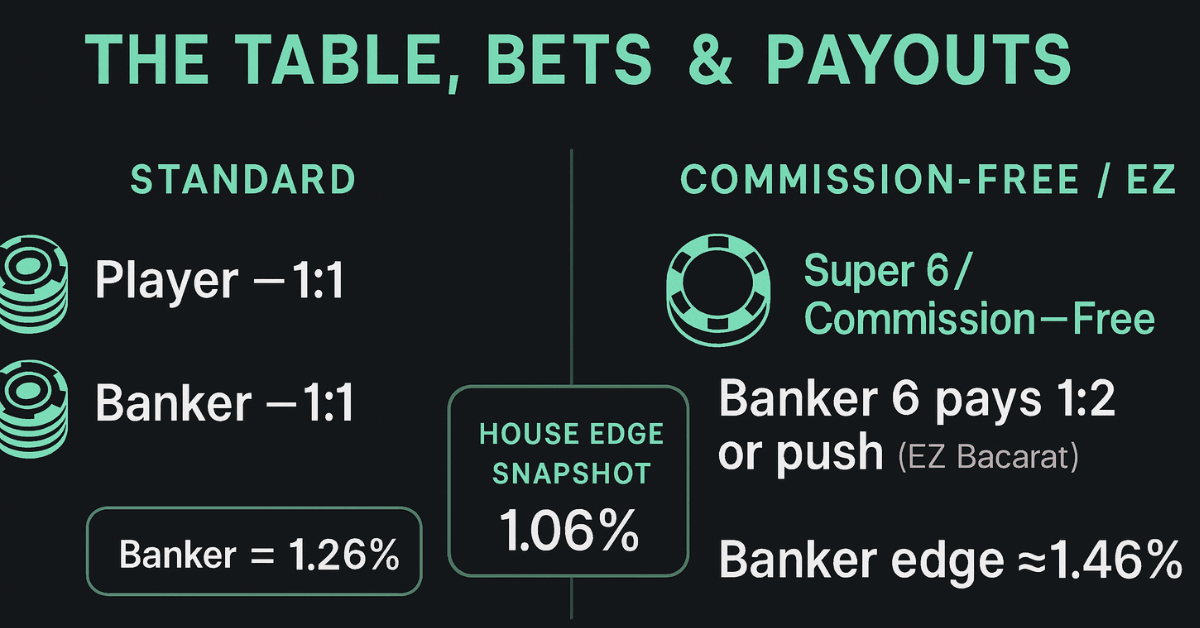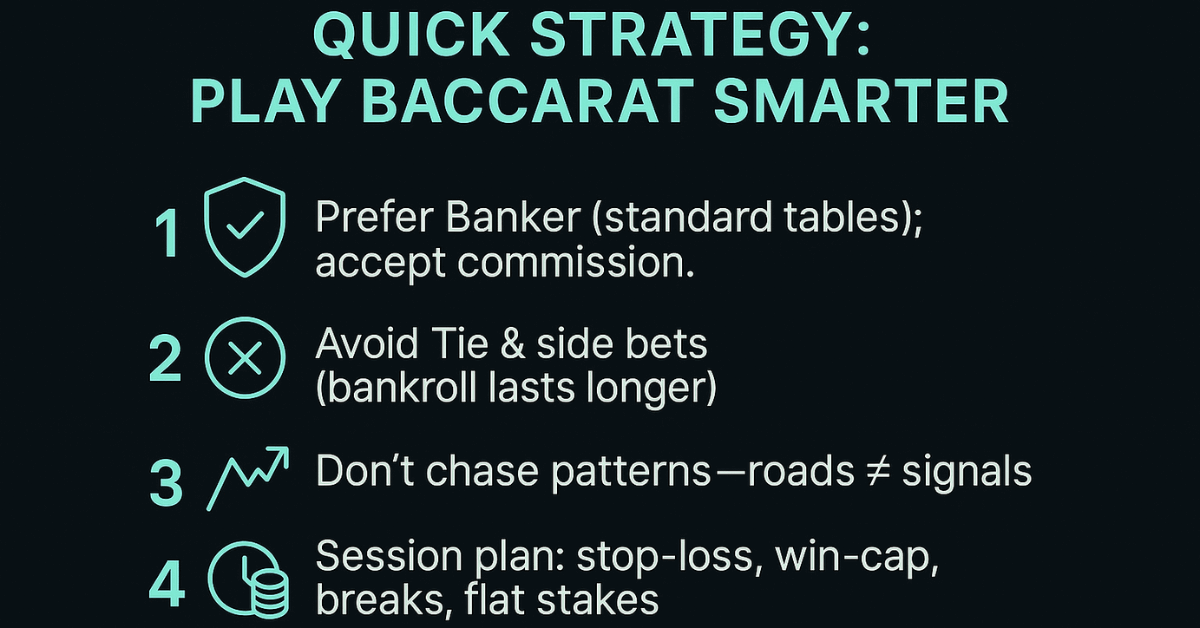Play Baccarat Demo
Deck-level promise: If you can add to nine, you can learn how to play baccarat confidently in 10 minutes. This guide shows the rules, the only bets worth making, and the draw chart made simple—plus common variants you’ll meet online and in casinos.
You’re eyeing a baccarat table and wondering if there’s a catch. There is—but it’s on the Tie and flashy side bets. This guide shows you how to play baccarat in minutes, why Banker is quietly the best bet, and how to read the third-card rule without memorizing a grid.
Quick Answer (By the Numbers)
- Objective: Bet on the hand (Player or Banker) that finishes closest to nine; you can also bet on a Tie. 10s and face cards = 0; Aces = 1.
- Best bet: Banker (pays 1:1 minus 5% commission) with a ~1.06% house edge over the long run. Player ≈ 1.24%; Tie ≈ 14.36% (avoid). These figures assume 8 decks and standard payouts.
- Third-card rule (simple): If anyone has 8 or 9 (“natural”) → both stand; else Player draws on 0–5, stands on 6–7. Banker’s draw depends on its total and (if drawn) the Player’s third card.
- Commission-free variants: “Super 6 / Commission-Free” pays even money on Banker except certain totals (e.g., Banker 6 pays 1:2); the Banker edge rises to ~1.46%.
Table of Contents
- What Is Baccarat & Why Players Love It
- Card Values & Scoring (with quick examples)
- The Table, Bets & Payouts (standard vs. variants)
- Step-by-Step: How to Play a Hand (Mini/Punto Banco)
- Third-Card Rule—Decoded (no math degree required)
- House Edge & Payout Math (Banker vs Player vs Tie)
- Popular Variants: Mini, EZ/Commission-Free, Chemin de Fer & more
- Side Bets (Dragon 7, Panda 8, Pairs, Big/Small)—what to skip
- “Roads” & Scoreboards: Myths vs. Math
- Bankroll, Limits & Table Etiquette (fast checklist)
- Quick Strategy: A realistic way to play smarter
- FAQ – How To Play Baccarat
What Is Baccarat & Why Players Love It
Baccarat (the punto banco version you see in most casinos and online) is a compare-the-totals game. Two hands—Player and Banker—are dealt. You bet on which will finish closer to nine, or on a Tie. You’re not “playing against” the dealer the way you do in blackjack—you’re betting on outcomes, more like wagering on a coin toss with slight edges baked in.
Why it’s popular:
- Simplicity: very few decisions for you to make—the draw rules are automatic.
- Low house edge: Banker and Player bets are among the fairest in the casino.
- Fast play: especially on Mini-Baccarat tables, with lower minimums.
Card Values & Scoring (with quick examples)
- Aces = 1, 2–9 = face value, 10/J/Q/K = 0.
- Totals use “modulo 10”: if your sum is 15, the hand’s value is 5; 20 → 0.
- Natural: a two-card 8 or 9; if any side has it, no more cards are drawn.

Examples:
- 7 + 3 = 10 → value 0
- 9 + Ace = 10 → value 0
- 4 + 5 = 9 (natural) → draw ends immediately
The Table, Bets & Payouts (standard vs. variants)
Standard bets (Punto Banco/Mini-Baccarat):
- Player — pays 1:1
- Banker — pays 1:1 minus 5% commission (effectively 19:20)
- Tie — usually pays 8:1 (sometimes 9:1/9-for-1 depending on venue)

House edge snapshot (8 decks, standard payouts):
Banker ≈ 1.06%, Player ≈ 1.24%, Tie ≈ 14.36%. That’s why seasoned players avoid Tie and most side bets.
Commission-free tables (what changes):
In “Super 6/Commission-Free,” Banker wins pay even money except on a specific total (e.g., Banker 6), which pays 1:2 or may push in EZ Baccarat. This tweak bumps the Banker edge to ~1.46%—still OK, but worse than standard Banker.
Step-by-Step: How to Play a Hand (Punto Banco/Mini)
- Place your bet on Player, Banker, or Tie.
- Dealer deals two cards to Player and Banker.
- If either side has 8 or 9, both stand (no more cards).
- Otherwise, Player may get a third card (automatic rule: draws on 0–5, stands on 6–7).
- Banker’s action depends on the Banker’s total and—if applicable—the Player’s third card (see section 5).
- Closest to 9 wins; payouts as above; Banker commission is collected on Banker wins at standard tables.
The Third-Card Rule—Decoded (No Math Degree Required)
Think of it in two layers:
Layer A—Easy part (Player hand):
- Player draws one card on 0–5; stands on 6–7; natural 8–9 stands.
Layer B—Banker logic (depends on Player):
- If Player stood (i.e., Player has 6–7): Banker draws on 0–5, stands on 6–7.
- If Player drew, the Banker rule looks at its own total and the Player’s third card. For example, Banker total 3 draws unless Player’s third card was an 8; Banker 4 draws if Player’s third card was 2–7; Banker 5 draws if Player’s third card was 4–7; Banker 6 draws only if Player’s third card was 6–7. (Casinos post the full matrix; you just need the idea.)
You don’t decide any of this at a standard table—the dealer executes these rules automatically.
House Edge & Payout Math (Why Banker Is Best)
Because the Banker hand acts last under rules slightly favoring it, it wins a hair more often. The 5% commission evens that advantage—which is why the Banker bet still ends up with the lowest house edge (~1.06%). The Player bet is a close second (~1.24%). The Tie looks juicy at 8:1, but math crushes it (≈14.36% edge to the house).
Commission-free tweaks (Super 6/EZ): compensation for skipping commission reduces the Banker value; expect ~1.46% edge vs 1.06% on standard tables.
Plain-English takeaway: If you’re here to stretch your bankroll, prefer Banker, accept commission, and skip Tie/side bets.
Popular Variants You’ll See
- Mini-Baccarat: Same rules on a smaller table; faster pace; lower minimums.
- EZ Baccarat: Pays even money on Banker except when Banker wins with a three-card 7, which pushes. Often features Dragon 7 (40:1) and Panda 8 (25:1) side bets.
- Commission-Free (“Super 6”, “Punto 2000”): Banker 6 wins pay 1:2; raises Banker edge to about 1.46%.
- Chemin de Fer / Baccarat Banque: European, player-banked versions where participants may choose to draw/stand (more player agency, different procedure). Modern casinos mostly deal punto banco, but it’s good history.
Side Bets—Fun, but (Usually) Bad Math
Common side wagers include Pairs (Player/Banker Pair), Dragon 7 (EZ), Panda 8, 3-Card Wins, Big/Small (total cards dealt). They inflate house edge compared to the main game. Example: Dragon 7 pays 40:1 with a ~7.6% house edge; Big/Small hover around 4–5%+; “3-Card Wins” pays 4:1 (Player) / 5:1 (Banker). If you’re optimizing, skip them.
“Roads,” Scoreboards & Streaks—Myths vs. Math
Casinos show “roads” (Big Road, Big Eye Boy, Small Road, Cockroach Road, Bead Plate) to visualize past outcomes. They’re entertaining, but they don’t predict the next hand—each coup’s odds are effectively the same given a full shoe and fixed rules. Pattern-chasing doesn’t change house edge.
Bankroll, Limits & Table Etiquette (Fast Checklist)
- Know the minimum/maximum and whether you’re on standard or commission-free rules. (Ask: “Is Banker 6 paid 1:2 or push?”)
- Commission box: On standard tables, Banker wins pay 1:1, and the dealer books 5% commission (some settle commission at shoe end).
- Touch/No-touch: Mini-Baccarat typically no-touch; Chemin de Fer/Midi may permit handling.
- Responsible play: set time & money limits before you sit; use casino tools (reality checks, timeouts).
Quick Strategy: A Realistic Way to Play Smarter
- Prefer Banker on standard tables; accept commission. Over time, it’s the best of the base bets.
- Avoid Tie/side bets if your goal is longevity/value.
- Don’t chase patterns—roads are souvenirs, not signals.
- Mind your session plan: set a stop-loss and a win-cap; take breaks; keep stakes consistent.

Want deeper math context? See our explainer on RTP.
FAQ – How To Play Baccarat
Is baccarat a game of skill?
In punto banco/mini-baccarat, the drawing is fixed—your decision is which bet to place. European variants like Chemin de Fer add player choices, but most online/casino tables are fixed-rule punto banco.
How many decks?
Most standard games use 6–8 decks; many casinos use 8-deck shoes today.
Best bet long term?
Banker (≈ 1.06% house edge). Player ≈ 1.24%; Tie ≈ 14.36%.
Why does Banker pay less?
Because Banker acts with a rules advantage; the 5% commission balances that.
What about “Super 6”/EZ?
Commission-free tweaks increase Banker’s edge to ~1.46% or create pushes on specific totals (EZ).
Can card counting beat baccarat?
Counting can slightly lower the edge in niche spots but generally doesn’t flip the game in your favor—not worth the effort for most players.
Are online games fair?
At regulated casinos, results are governed by RNG and audited; seek licensed sites and responsible gaming tools. (See internal link to RNG, which explains RNG and licensing principles applicable to table games, too.)
How to Play Baccarat Long Summary
How the Game Flows (Start to Finish)
Place your chip on Player, Banker, or Tie. The dealer delivers two cards to each hand. If anyone shows 8 or 9, that’s a natural—the coup ends, and payouts follow. Otherwise, the Player may receive a third card (0–5 draw; 6–7 stand), and then the Banker acts based on a short set of rules tied to its total and, if applicable, the Player’s third card. Closest to nine wins. That’s the whole game.
Why Banker Is Marginally Better (but Not Magic)
Baccarat is designed so the Banker has a subtle structural edge (it often acts after the Player and draws with slightly better information). Casinos charge 5% on Banker wins to level that edge, which is why Banker still ends up the best long-term pick at around 1.06% house edge—Player is close behind at 1.24%. The Tie bet’s 8:1 payout looks tempting, but the math lands at ≈14.36% house edge, which is rough for bankroll longevity.
Third-Card Rule—What You Really Need to Remember
- Player rule is easy: 0–5 draw, 6–7 stand, natural 8–9 stand.
- Banker mirrors Player if Player stood: 0–5 draw, 6–7 stand.
- Otherwise (when Player drew), Banker’s action references a small chart most tables print on the felt or display. You don’t need to memorize it—only know that it’s automatic and slightly favors Banker over many sequences.
Commission-Free & EZ Baccarat—Read the Small Print
If you want even-money Banker without commission, you’ll often give something back when Banker wins with specific totals (e.g., 6 pays 1:2 or 3-card 7 pushes). Net result: slightly worse for you versus standard Banker, but still fine if you prefer simpler payouts.
Side Bets: Entertainment Tax
- Dragon 7 (EZ) — Banker wins with a 3-card 7 (40:1), ~7.6% house edge.
- Panda 8 — Player wins with a 3-card 8 (25:1).
- Pairs / Big-Small / 3-Card Wins — payouts vary; edges are multiple times higher than the main bets. If your goal is value, skip them.
Trends & “Roads”: Fun to Track, Not to Trust
The famous scoreboards (Big Road, Big Eye Boy, Small Road, Cockroach, Bead Plate) map history, not the future. On fixed-rule punto banco, past hands don’t alter the next hand’s odds. Look if you enjoy it—but don’t adjust your expectations because a column looks “hot.”
Live vs. Online: What Changes?
- Live Mini-Baccarat: social table, chips, fast dealing.
- Online/Live-dealer: same rules; check table minimums and variant (EZ vs. standard). Both environments should be licensed and GameSense/Responsible Gambling-aligned.
Bankroll & Session Planning (Practical)
- Pick a flat unit (e.g., 1%–2% of your bankroll).
- Decide entry/exit rules: +X units = take a break; −Y units = stop.
- Avoid progression systems (they don’t change expectation; they just change variance concentration).
Conclusion: How to Play Baccarat the Smart Way
If you remember just three things, you’ll play baccarat confidently: aim for the hand closest to nine, favor Banker on standard tables, and skip Tie and side bets. The third-card rule is automatic—dealers follow it for you—so your real edge comes from choosing the right wager and managing your bankroll. Commission-free/EZ versions are fine for simplicity, but standard Banker (with 5% commission) remains the best long-run value. Scoreboards and “roads” are fun to watch, not signals to chase.
Quick checklist before you sit down:
- Confirm the table type: standard, Super 6/commission-free, or EZ.
- Lock your limits (time and money) and stick to flat stakes.
- Default to Banker; use Player occasionally; avoid Tie/side bets.
- Take breaks—fast games reward clear thinking, not speed.
That’s the essence of how to play baccarat well: simple rules, disciplined choices, and respect for the math. If you want to go deeper, read our primers on House Edge, RNG & Fairness, and Responsible Gambling —then bring that know-how to the felt.
More in-depth guides for all types of baccarat can be found here.